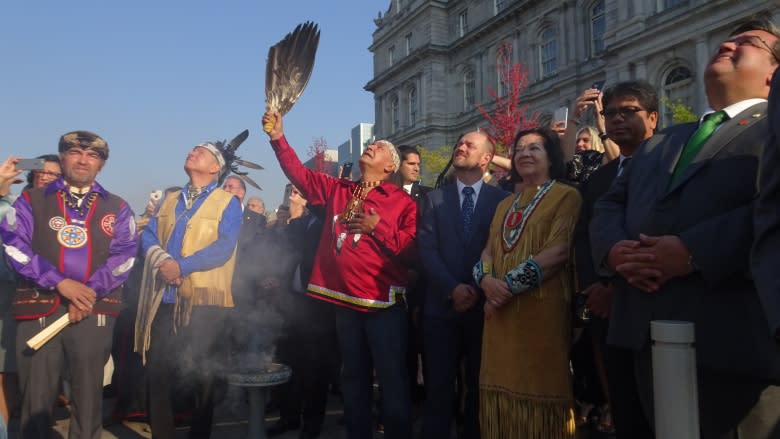Montreal adds Iroquois symbol to flag, strips British general of street name
Montreal has taken steps to recognize the contribution of Indigenous people to the city, adding an Iroquois symbol to its city flag and committing to rename Amherst Street.
The street was originally named after British Gen. Jeffery Amherst, who advocated giving smallpox-laced blankets to Indigenous peoples.
Mayor Denis Coderre unveiled the new flag, which features a white pine tree at its centre, on Wednesday alongside Ghislain Picard, chief of the Assembly of First Nations for Quebec and Labrador.
The announcement was made on the 10th anniversary of the United Nations Declaration on the Rights of Indigenous Peoples.
The white pine, described as the Great Tree of Peace, is a symbol of the unity of the five nations of the Haudenosaunee Confederacy — also known as the Iroquois Confederacy or the League of Five Nations — which includes the Mohawks.
Kahnawake Mohawk Council Chief Christine Zachary-Deom said it was moving to see the new flag raised at city hall.
"When we come from people who have been forgotten for such a long time, it is very touching to find that we are supported," she said following the ceremony.
Moving toward reconciliation
Speaking at the announcement, Coderre said the change is part of an effort to move toward reconciliation with Indigenous people.
"Today is a historical day for Montreal," he said.
Picard also praised the decision to add an Indigenous symbol to its flag.
"The raising of the flag is giving me hope that the connection to this territory is finally acknowledged and recognized," he said.
On Twitter, Prime Minister Justin Trudeau called it a "tremendous and historic step forward for Montreal."
The old flag featured symbols representing four of the city's founding communities. They are still featured in the new version:
- A Fleur-de-lys, representing the French.
- A red Rose of Lancaster, representing the English.
- A thistle, representing the Scots.
- A shamrock, representing the Irish.
'Goodbye, Mr. Amherst'
Coderre also confirmed the change for Amherst Street.
Scholars have long debated Amherst's actions during his service, including evidence he advocated the use of biological warfare, through smallpox blankets, to kill Indigenous people.
Picard said Amherst represented "a very dark stain on our history," and agreed it should be removed.
"Goodbye, Mr. Amherst," Coderre said in a speech marking the UN declaration.
"If we want reconciliation, I don't think we should celebrate someone who wanted to exterminate Indigenous peoples."
The city has not yet decided on a new name for the street, but said it will be connected to the native community.
"It could be the name of a native chief, or called the avenue of reconciliation. I don't know," he said.



